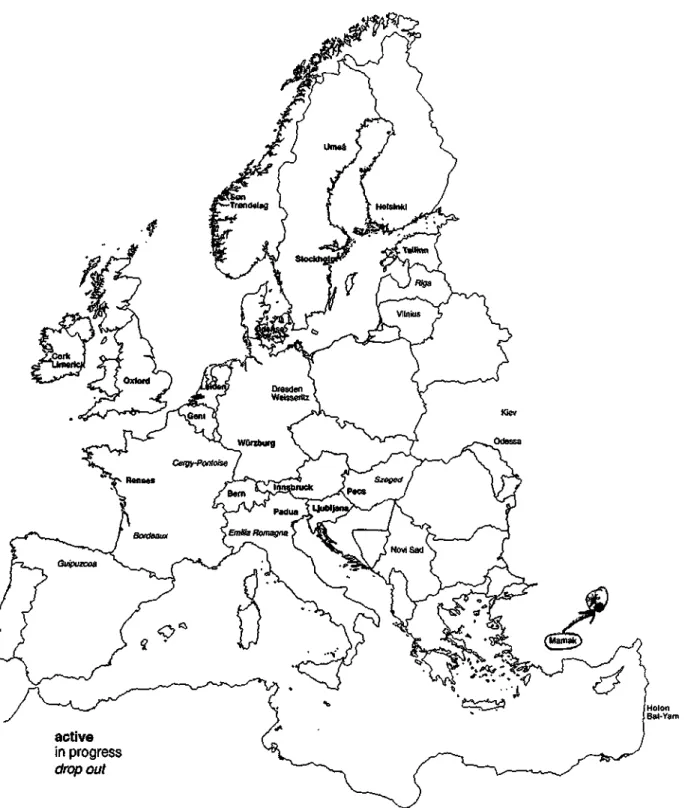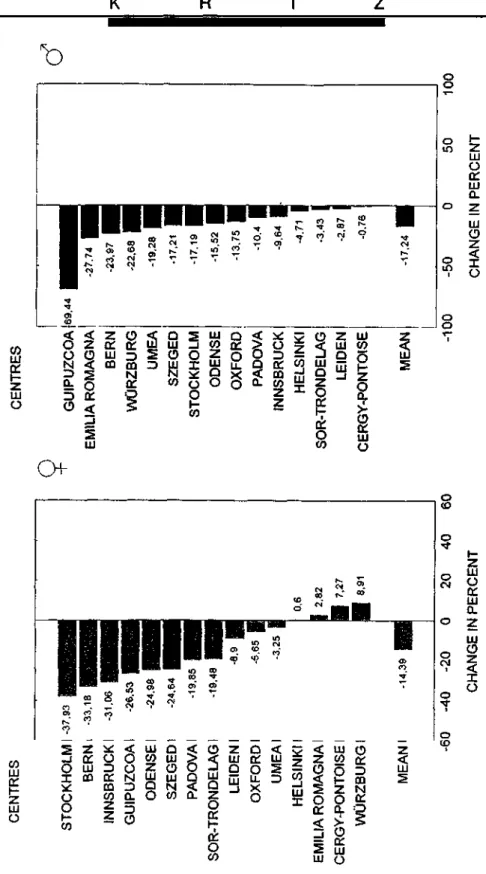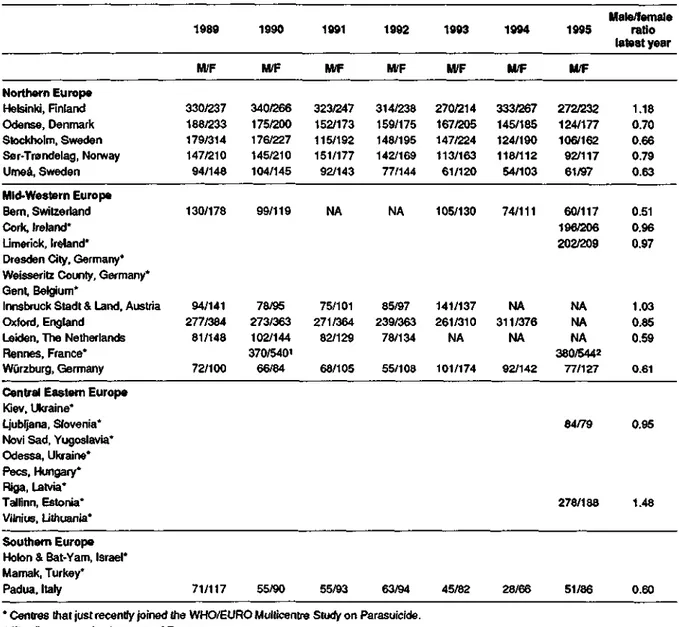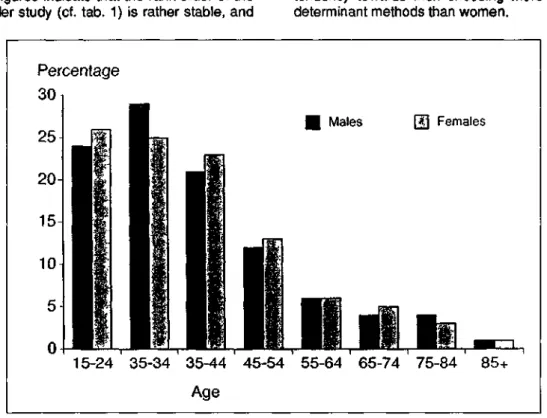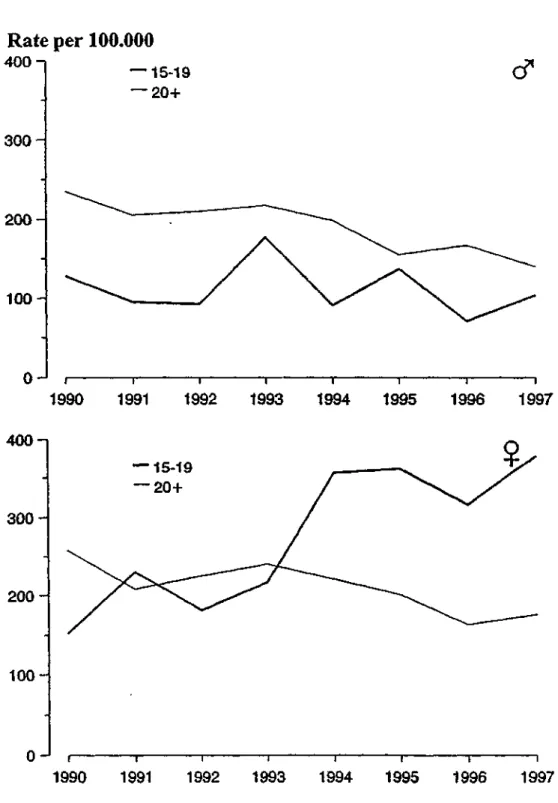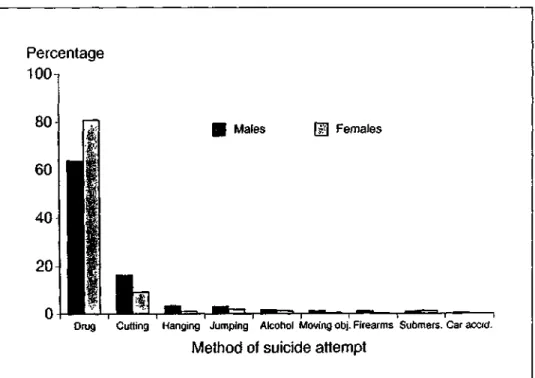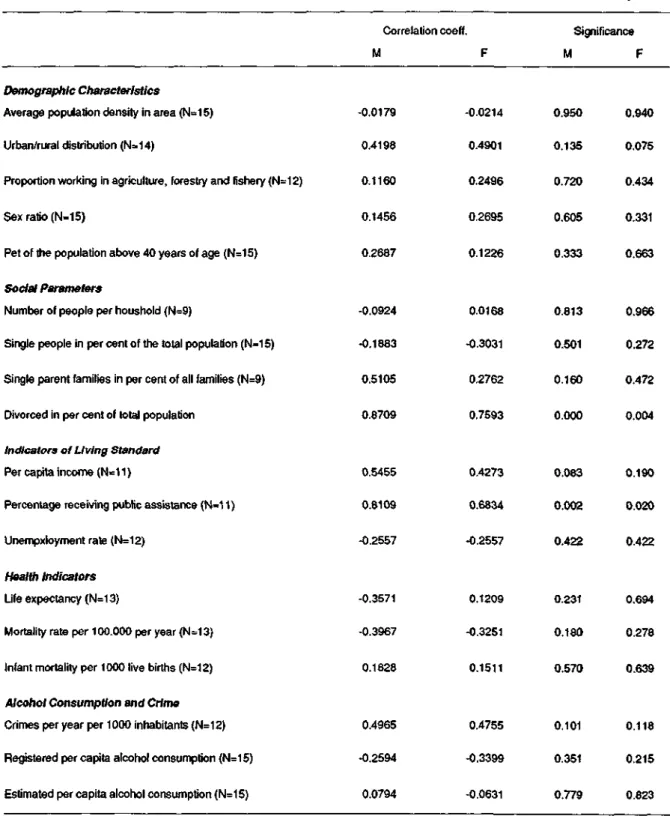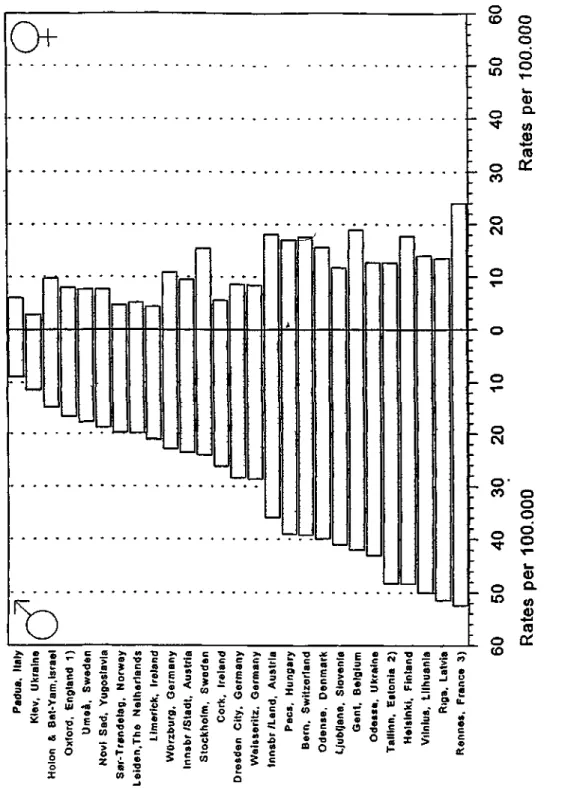Kriz Dergisi 9 ( 1 ) : 19-32
THE EPİDEMIOLOGY OF SUICIDE ATTEMPTS İN EUROPE+
Dr. Unni Bille-BRAHE*Avrupa'da İntihar Girişimlerinin Epidemiyolojisi ÖZET
Son 20-30 yıldır, ölümcül olmayan intihar dav ranışları bir çok üldeke büyüyen bir sorun olmuş tur. Bir çok batı ülkesinde ölümle sonuçlanan inti harlar 100 yıldan daha uzun bir süredir kaydedilmektedir. Ancak intihar girişimlerine ait ulusal istatistikleri tutan hiçbir ülke yoktur. Bu ne denle Dünya Sağlık Örgütü (DSÖ) Avrupa Bölge sel Ofisi 1980'lerin ortalarında Avrupa ülkeleri ara sında intihar girişimleri ile ilgili bir çalışma başlatmıştır. "DSÖ/Avrupa Çok Merkezli intihar Davranışı Çalışması". Çalışmanın iki bölümü var dır: izleme Çalışması ve Tekrarlanan intihar Giri-şimlerindeki Risk Faktörlerinin Belirlenmesi Çalış ması. İzleme Çalışması 1989'da başlatılmıştır. Başlangıçta çalışmaya 16 merkez katıldı. Ancak bunlardan bazıları bu konuya ayrılan ulusal kay nakların yetersizliği nedeniyle çalışmadan ayrılmak zorunda kaldı. Bununla beraber, yeni merkezler çalışmaya katılmak istediler. Bugün için çalışmanın İzleme Bölümü'nde 24 merkez yer almaktadır. 1989-1992 yılları arasında, 22.655 intihar girişimi bildirilmiştir. Avrupa'da yaşa göre standardize edil miş intihar girişimi hızı erkeklerde 100.000'de 136 ve kadınlarda 100.000'de 186'dır. Erkeklerde en yüksek yaşa özel hız 25-34, kadınlarda ise 15-24 yaş gruplarında saptanmıştır. Bu dönem içinde er keklerin intihar hızlarında % 17, kadınların intihar hızlarında ise % 14 düşüş olmuştur. Bununla birlik te bir çok merkez genç kadınlardaki intihar
girişim-+ 36. Ulusal Psikiyatri Kongresi'nde Konferans konuşması olarak sunulmuştur.
Dr. Sosyolog WHO Collaborative Centre for Prevention of Suicide Odense, Denmark.
terinde endişe verici bir artış olduğunu bildirmekte dir. Genel olarak en sık kullanılan intihar girişimi yöntemi ilaçla kendini zehirlemedir. Erkekler kadın lara göre daha saldırgan intihar yöntemlerini tercih etme eğilimindedirler.
Anahtar Kelimeler: İntihar, intihar girişimi, in tihar davranışı, epidemiyoloji.
SUMMARY
During recent decades, non-fatal suicidal behaviour has become a problem of increasing concern in mostcountries. Contrary to fatal suicidal acts that most westem countries have been registering for more than 100 years, no country can provide national statistics on suicide attempts. For this reason, the European Regional Office of the World Health Organisation initiated an inter-European study on suicide attempts in the mid-1980's. "The WHO/Euro Multicentre Study on Suicidal Behaviour". There are two parts of the study: The Monitoring Part and The Repetition Prediction Study. The Monitoring study started in 1989. Originally, 16 centres participated, butdue to lack of national funding some had to leave the study. On the other hand, new centres have wanted to take part, and as of today, 24 centres are included in the monitoring part of the project. During the period of 1989-1992, 22.655 episodes of attempted suicide were reported, and age-standardised average rates per 100.000 in Europe were estimated to 136/100.000 for males and 186/100.000 for females. The highest age-specific rates for men were found among the 25-34 year-olds and for vvomen among the 15-24 year-olds. There was a decrease during the period in the total rates of about 17% for men and 14% for
women. Most centres are, hovvever, expressing vvorries conceming markedly increasing frequencies of suicide attempts among the young girls. İn general the far most common method is self-poisoning, usually with overdoses of medicine. There is a tendency tovvards men choosing more violent or determinant methods than vvomen.
Key VVords: Suicide, suicide attempt, suicidal behaviour, epidemiology.
INTRODUCTION
During recent decades, non-fatal suicidal behaviour has become a problem of increasing concem in most countries. Although there has been a marked development in the medical treatment after a suicidal act and therefore greater probabilities of saving and survival, the frequency of non-fatal suicidal acts has been increasing vvith an almost epidemic speed. İt is therefore argued that the majority of these suicide attempts cannot be seen as 'unsuccessful suicides', but rather as a special 'new' type of suicidal behaviour that is not necessarily motivated by 'a wish to die', but which is aiming at provoking changes in problematic or painful situations so that life (again) will be worth living.
Hovvever, contrary to fatal suicidal acts that most vvestem countries have been registering for more than 100 years, no country can provide national statistics on suicide attempts, and our knovvledge of the frequency of attempted suicide,
of risk factors and high-risk groups, and of characteristics of suicide attempters has so far been based on results from various separate studies wihch have been difficult to compare and to draw general conclusions from because of differences in chaice of method, case-finding criteria, ete.
For these reasons, the European Regional Office of the VVorld Health Organization initiated an inter-European study on suicide attempts in the mid-1980's. The WHO/Euro Multicentre Study on Parasuicide (from 1998 on titled The WHO/Euro Multicentre Study on Suicidal Behaviour) was to cover two broad areas of research:
* monitoring trends in the epidemiology of parasuicide, ineluding identifying risk factors (the Monitoring Study); and
* condueting follow-up studies of parasuicide populations as a special high-risk group for further suicidal behavior (the Repetition-Prediction Study).
The main topic of this article will be the methods of and some results from the Monitoring Study.
The Monitoring study started in 1989. Originally, 16 centres participated, but due to lack of national funding some had to leave the study. On the other hand, new centres have wanted to take part, and as of today, 24 centres are ineluded in the monitoring part of the project.
Table 1. Status of centres participating in the WHO/Euro Multicentre Study on Suicidal Behaviour. Old centres
Bern, Svvitzerland Helsinki, Finland
Innsbruck Stadt & Land, Austria Odense, Denmark Oxford, UK Padova, Italy Sar-Trandelag, Norvvay Stockholm, Svveden Umeâ, Svveden VVûrzburg, Germany Leiden, The Netherlands No more participating Bordeaux, France Cergy-Pontoise, France Emilia Romagna, Italy Guipûzcoa, Spain Novi Sad, Yugoslavia Vilnius, Lithuania New Centres Mamak, Turkey Athens, Greece Cork, Ireland Gent, Belgium Holon, Israel Limerick, Ireland Ljubljana, Slovenia Pecs, Hungary Rennes, France Tallinn, Estonia Riga, Latvia
Applied for parttetpatlon Kiev, Ukraine
Odessa, Ukraine
(T
Dresden Wetsseritz * ' Riga Vilnius Kiev warzburg Cergy-Pontoise • Rennes Bordeaux "Bern * ^ S & ^ ^ P « s Pa«UıaAlJuW*i \ Emilia Romagna . Szeged , Guipuzcoa active in progress drop out<T
<û\ t^Cİ3d İ (Holon i Bat-YamInitially, four main purposes were listed for this part of the project:
* to assess feasibility of using local case registers to monitör attempted suicide in defined catchment areas. The catchment areas are supposed to cover at least 200.000 inhabitants (15yearsandover)
* to estimate the true incidence of medically treated suicide attempters and trends över time, using standardized definitions and case-finding criteria
* to identify sociodemographic risk factors significantly associated with attempted suicide * to ascertain variations in patterns of treatment
following attempted suicide in different cultural contexts (with the aim of establishing more effective services for preventing this type of suicidal behaviour).
Already in the planning phase did it become clear that for several reasons existing local case registers could not provide sufficiently reliable data. A special monitoring of suicide attempts, using uniform monitoring forms and the same case finding criteria, was therefore to be carried out at ali centres on consecutive episodes in ali places vvhere suicide attempters were seen and/or treated by health personnel. A suicide attempt was defined as:
"an act with non-fatal outcome, in which an individual deliberately initiates a non-habitual behaviour that, if vvithout intervention from others, will cause self-harm, or deliberately ingests a substance in excess of the prescribed or generally recognized therapeutic dosage, and vvhich is aimed at realizing changes vvhich the subject desires via the actual or expected physical conseçuences".
The definition includes acts that are interrupted before the actual self-harm occurs (e.g. if a person is removed from the railvvay track before the train arrives), but excludes acts of self-harm by persons who do not understand the meaning or the consequences of their act (e.g. because of mental retardation or severe mental illness). This operational definition does not specify the strength of the wish to die, since this is almost impossible to ascertain. That is ali intentional self-destructive behaviours are included, as long as these behaviours appear to be intended to bring
about changes in the present situation. For a discussion on the use of the terms parasuicide and attempted suicide, see Bille-Brahe et al. 1994.
Ali monitoring data are then transferred to the centre in VVürzburg, vvhere they are checked, coordinated and re-checked by prof. Armin Schmidtke and his co-workers.
To provide an adequate epidemiological description of the areas under study, each participating centre has been required to submit standardized information about the catchment area in question, including general background data such as the size and location of the area, the breakdovvn of the population according to age, sex and civil status, housing, urban/rural areas and unemployment rates, together with the main industrial and economic activities of the area. These pieces of background information have been gathered at the centre in Odense and published in the booklet "Facts & Figures" (Bille-Brahe (ed), 1999).
DATA ON ATTEMPTED SUİCİDE İN EUROPE
Data from 15 centres for the first five-year period (1989-1993) vvere published in 1994 in the book Attempted Suicide in Europe (Kerkhof et al. 1994) and in an article Attempted suicide in Europe: rates, trends and sociodemographic characteristics of suicide attempters during the period 1989-1992 (Schmidtke et al. 1996). İn ali 22.655 episodes of attempted suicide vvere reported, and age-standardized average rates per
100.000 in Europe vvere estimated to 136/100.000 for males and 186/100.000 for females. There was, hovvever, huge differences betvveen the various areas under study: for men it varied from 314/100.000 (in Helsinki) to 45/100.000 (in Guipüzcoa), and for vvomen from 462/100.000 (in Cergy-Pontoise) to 69/100.000 (in Guipüzcoa). The highest age-specific rates for men vvere found among the 25-34 year-olds and for vvomen among the 15-24 year-olds.
İn general, there was a decrease during the period in the total rates of about 17% for men and 14% for vvomen. İt should be noted, hovvever, that in four areas, namely Helsinki, Emilia Romagna, Cergy-Pontoise, and VVürzburg total female rates had been increasing.
Table 2 gives an overvievv of the rates of attempted suicide in the various part of Europe up to 1995
t)
« s CM •*> 2 S ^1co
p
z
LU O <o
o
N 0. D (D < Z O <o
K < û 2 UJ û LU _ı co a: O O z nuı i w
LUO
N SE co Q OSİ
CO B O LU Q z o o: \-0£ O CO < LU CO -J Q r! Z O û. >^ LU O O o LU ü OT LU û . Z LU CD Z < X üi
co LU OC 1 -z LU O ? _1 O T V O Oz
ne
LU t ü *:u
L3 d CO COz
<o
o
N 3 D.r)
LU Q CO LU Z O LU UJ Q N O CO1
Q CO S Ü5
LU Q Z O a: a: o co z LU g LU Oo:
o
u_ X.o
< LUz>
3 ^ 2 l/J - 1 LU X <z
ü < > EMILI A R O LU CO Dt-z
CERGY-P O O (T ->m
N et 7 < LU :> o «O Z LU O CCt LU 0 . z LU O z < X oFig. 2. Percentage changes in rates of attempted suicide (persons) by sex, 1989-1992 in 15 European areas under study (Bern 1989-1990, Cergy-Pontoise and Guipüzcoa 1989-1991).
Table 2. Rates of attempted suicide (events) per 100.000.15 years and older, in the areas under study. 1989-1995. Northern Europe Helsinki, Finland Odense, Denmark Stockholm, Sweden Sar-Trandelag, Norway Umeâ, Sweden 1989 M/F 330/237 188/233 179/314 147/210 94/148 1990 M/F 340/266 175/200 176/227 145/210 104/145 1991 M/F 323/247 152/173 115/192 151/177 92/143 1992 M/F 314/238 159/175 148/195 142/169 77/144 1993 M/F 270/214 167/205 147/224 113/163 61/120 1994 M/F 333/267 145/185 124/190 118/112 54/103 1995 M/F 272/232 124/177 106/162 92/117 61/97 Male/female ratio latest year 1.18 0.70 0.66 0.79 0.63 MId-Western Europe Bern, Switzerland 130/178 99/119 NA NA 105/130 74/111 Cork, Ireland* Limerick, Ireland* Dresden City, Germany* VVeisseritz County, Germany* Gent, Belgium*
InnsbruckStadt&Land.Austria 94/141 78/95 75/101 85/97 141/137 NA Oxford, England 277/384 273/363 271/364 239/363 261/310 311/376 Leiden, The Netherlands 81/148 102/144 82/129 78/134 NA NA Rennes, France* 370/5401 VVürzburg, Germany 72/100 66/84 68/105 55/108 101/174 92/142 60/117 196/206 202/209 NA NA NA 380/5442 77/127 0.51 0.96 0.97 1.03 0.85 0.59 0.61
Central Eastern Europe
Kiev, Ukraine* Ljubljana, Slovenia* Novi Sad, Yugoslavia* Odessa, Ukraine* Pecs, Hungary* Riga, Latvia* Tallinn, Estonia* Vilnius, Lithuania* 84/79 278/188 0.95 1.48 Southern Europe
Holon & Bat-Yam, Israel* Mamak, Turkey*
Padua, Italy 71/117 55/90 55/93 63/94 45/82 28/66 51/86 0.60 * Centres that just recently joined the VVHO/EURO Multicentre Study on Parasuicide.
1 The figures are for the town of Rennes. 2 The figures are for the Catchment area.
İn the publications mentioned above, an apparent increase in the sex ratio (m/f) was discussed İt is interesting to note that in 1995, there was an overvveight of men attempting suicide in three of the 15 areas under study, namely Helsinki, Innsbruck, and Tallinn. Furthermore, in
the two Irish areas, and in Ljubljana the ratios are now getting close to 1.
Fig. 3 shovvs the latest data available on the frequency of attempted suicide. Data on the second five-year peiod 1993-1997 will be published shortly
lOCOT-COlOlOCMCOOOCDCOCOCDCMCOCDlOinCM.- /rt 0)0>0)0>0)0>C3îO)0>COO>0>0>0)0)a)0)0)CöO> vJ O) O) O) O) O) O) O) Oî O) O) O) O O) O) 0>0> 05 0>0> O) < ÛC^COZÜÛClUWüDûCJ<UJ0C>ZLiJ2O <
0^nZ3S
0^
zP
<Î30-JûuJO<SOü
oSo
1
"!
w o
g§§gg ^ Q9=
Q_ >^ LUü
o
LLIo
o
CDo
o
o
o
^to
o
co
o
o
CMo
o
o
o
o
o
CMo
o
co
o
o
•3-o
o
10
o
o
co
Fıg. 3. Age-standardızed rates of attempted suicıde (events) per 100.000,15 years and older. Latest available year (-1996).
The figures indicate that the rank-order of the areas under study (cf. tab. 1) is rather stable, and
so is the distribution on age: in ali areas the highest rates are to be found among the young.
Most centres are, hovvever, expressing vvorries conceming markedly increasing frequencies of suicide attempts among the young girls. As yet, no pooled data on age-specific rates from the latest years are available, but as an illustration of the problem, Danish rates of attempted suicide for 15-19 year-olds and for persons 20 years and older are shovvn in fig. 5.
The figüre shows that while rates of attempted suicide in Denmark have göne down for ali age groups and for both sexes, during the 1990's the
15-19 year-old girls have almost tripled their rate. The choice of method does differ betvveen the areas, but in general the far most common method is self-poisoning, usually with overdoses of medicine. İn particular, overdoses of various types of mıld analgesics, especially Paracethamol agents, are very common among young girls. İt can be seen from the figüre, that there is a
tendency tovvards men choosing more violent or determinant methods than women.
SOCIODEMOGRAFHIC CHARACTERISTICS
International literatüre is rich on studies on risk factors and groups with increased risk for suicidal behaviour, and there seems to be a general agreement as to the importance of at least some parameters conceming demography, social conditions, living standard, health, and alcohol consumption and crimes. For this reason, questions relating to such conditions were included in the monitoring form, and descriptions of the relevant parameters were included in the booklet Facts & Figures. Results from the first period of the Monitoring Study confirm the existence of co-variations of certain sociodemographic and socioeconomic conditions, and the occurrence of attempted suicide (Schmidtke et al. 1994) and it was expected that there would be correlations between the rates of attempted suicide in the areas under study, and the said characteristics of the areas. Percentage 30 Males O Females
15-24 35-34 35-44 45-54 55-64 65-74 75-84 85+
Age
Rate per 100.000
400 -ı
3 0 0
-200
1 0 0
-— 15-19
— 20+
dr
0 — ı 1 1 1 1 1 1 11990 1991 1992 1993 1994 1995 1996 1997
400
3 0 0
2 0 0
1 0 0
-— 15-19
— 20+
O -* ı 1 1 1 1 1 1 11990 1991 1992 1993 1994 1995 1996 1997
Percentage 100-, 80 60 40 20
1
1
II
• |lı
U | | Orug Cutting B| Males O FemalesHanging Jumping Alcohol Moving obj. Firearms Submers. Car accıd. Method of suicide attempt
Fig. 6. Methods of suicide attempts (average percentages).
However, as can be seen from table 3, correlations significant on the 95% level were found regarding only two parameters, namely the frequency of divorce, and the number of people receiving public support (Bille-Brahe et al, 1996). Somevvhat surprisingly, no correlations were found betvveen e.g. unemployment or alcohol consumption, and the frequency of suicide attempts.
This raises the question and the need for further analyses: How then to explain the at times rather marked differences betvveen the areas under study in the frequency of attempted suicide?
ATTEMPTED SUİCİDE VERSUS COMPLETED SUİCİDE
From fig. 7 it is seen that the rate of completed suicide varies markedly betvveen the areas under study, too.
İn literatüre, it is often stated that the frequency of suicide attempts is probably 8-10 times higher than that of completed suicides. This might be true when mean total rates are concerned, but in fact the statement is a gross simplicism.
While the risk of completed suicide is highest among men and increasing with age, attempted suicides most often occur among young people and especially among young vvomen. Accordingly, the ratio suicide attempts/suicide differs -as shovvn in fig. 8.- markedly vvith sex. That the variation is even bigger betvven age groups can be illustrated vvith another example from the Danish area under study: here the ratio varies from 91:0 for 15-19 year-old girls to 1:1 for men 60 years and older.
İt is, hovvever, interesting to note that the ratio attempted suicide/completed suicide, at least vvhen it comes to mean or average rates, seems to be rather stable över the last many years. Considering the fact that the population of attempters and of suicides in many respects -as e.g. age and sex-differ significantly from each other (cf. Stengel, 1967), one may ask if there are some underlying factors or conditions that in some way influence the propensity to react to painful problems and sufferings vvith suicidal behaviour and that knovvledge on such factors also may tribute to an explanation of the differences betvveen the centres discussed above.
Table 3. Spearman's Rank correlations betvveen rates of parasuicide and some characteristics of the areas under study. Correlation coeff. M F Significance M F Demographic Characteristics Average population density in area (N-15)
Urban/rural distribution (N=14)
Proportion vvorking in agriculture, forestry and fishery (N=12)
Sexratio(N=15)
Pet of the population above 40 years of age (N=15)
Social Parameters
Number of people per houshold (N=9)
Single people in per cent of the total population (N=15)
Single parent families in per cent of ali families (N=9)
Divorced in per cent of total population
Indicators ofUving Standard Per capita income (N=11)
Percentage receiving public assistance (N=11)
Unempxloyment rate (N=12)
Health Indicators Life expectancy (N=13)
Mortality rate per 100.000 per year (N=13)
Infant mortality per 1000 live births (N=12)
Alcohol Consumption and Crime Crimes per year per 1000 inhabitants (N=12)
Registered per capita alcohol consumption (N=15)
Estimated per capita alcohol consumption (N=15)
•0.0179 0.4198 0.1160 0.1456 0.2687 -0.0214 0.4901 0.2496 0.2695 0.1226 0.950 0.135 0.720 0.605 0.333 0.940 0.075 0.434 0.331 0.663 •0.0924 •0.1883 0.5105 0.8709 0.0168 -0.3031 0.2762 0.7593 0.813 0.501 0.160 0.000 0.966 0.272 0.472 0.004 0.5455 0.8109 -0.2557 0.4273 0.6834 -0.2557 0.083 0.002 0.422 0.190 0.020 0.422 -0.3571 •0.3967 0.1828 0.1209 -0.3251 0.1511 0.231 0.180 0.570 0.694 0.278 0.639 0.4965 •0.2594 0.0794 0.4755 -0.3399 -0.0631 0.101 0.351 0.779 0.118 0.215 0.823
O
_ o
o <D O o "fr o 0 0 o CM o o o10
0
l_ <D a. w 0) ••-» C0 OL_ o
_ o
CM _ O " CO _ O _ O —» C O C 0 * D > * < B C "O > » > » «i * s I
*1
1
1
* -. a >• £ = Hol o la n c • o o X O V) « 0 E 3 Rz
l
s
z o z C 6 o ^3 a K erl e Net h o eld e a « i * o •c A IU1 | • J a E o O Ol 3 .O N O 5 5 S < — TJ S w • ^ »-.o u1
j - OI!
E o "5 Uil
3 S x ~ a »minin
m
o
o
o
ö
o
O . COo
(0 Dİ ö co coI H İ İ .
? u-C£ .5 =
o 5
o i l i
î
o. n 3 O o £ o JZ i a 0) o •_ . E ~ o E c -• - O ffl2 - S
o İS m •o 3 "= c o. « 3 O m + _ >.«
21
"5 2 - T İS 3 <D 'İS w a. o T- W (Ö"Fig. 7. Rates of completed suicide per 100.000 inhab. 15 years and older in the areas under study, latest available data (1991 to 1997).
HELSİNKİ OXFORD CERGY-PONTOISE SZEGED ODENSE STOCKHOLM SOR-TRONDELAG BERN UMEA INNSBRUCK LEIDEN VVÜRZBURG PADOVA GUIPUZCOA EMILIAROMAGNA AVERAGE
d"
#<//.7<?//M 600 500 400 300 200 100 0 20 40 60 80 100Attempted suıcide Completed suicide
CERGY-PONTOISE OXFORD STOCKHOLM HELSİNKİ ODENSE SZEGED SOR-TRONDELAG BERN UMEA LEIDEN INNSBRUCK PADOVA VVÜRZBURG EMILIA ROMAGNA GUIPUZCOA AVERAGE 600 500 400 300 200 100 0 20 40 60 80 100 Attempted sıucıde Completed sıncıde
CONCLUDING REMARKS
During later years, the rates of completed silicide have been decreasing in most VVestern European countries, while the frequency has been increasing markedly in the Eastern and Central European Countries (Bille-Brahe, 1998). İt is yet to be seen vvhether this pattem repeats itself regarding non-fatal suicidal acts but as more centres from the Eastern and Central part of Europe join the WHO/Euro Multicentre Study, the monitoring part of this project should be able to answerthisquestion.
So far we can conclude that as far as attempted suicide is concerned, a decrease has
REFERENCES
Bille-Brahe U. Suicidal Behaviour in Europe. The situation in the 1990s. WHO, Copenhagen, 1998.
Bille-Brahe U (ed). Facts and Rgures. 2nd. ed. WHO, Copenhagen, 1999.
Bille-Brahe U, Andersen K, VVasserman D, Schmidtke A, Bjerke T et al. The WHO/Euro Multicentre Study: Risk of Parasuicide and the comparability of the areas under study. CRISIS 1996,17/1:32-42.
Bille-Brahe U, Schmidtke A, Kerkhof AJMF, De Leo D, Lönnqvist J, Platt S. Background and the Introduction to the study. İn: Kerkhof et al (eds.) Attempted suicide in Europe. Findings from the Multicentre Study on Parasuicide by the WHO Regional Office for Europe. Chapter 1. pp. 11-15. DSWO Press, Leiden, 1994.
Kerkhof AJMF, Schmidtke A, Bille-Brahe U, De Leo D, Lönnqvist J. (eds). Attempted Suicide in Europe.
taken place in the majority of the VVestern European areas under study, but on the other hand we find that young people and especially young vvomen are at an increasing risk. There is, hovvever, a lack of correlations betvveen known risk factors and the frequencies of attempted suicide, and this -and also the apparent stability of the ratio attempted suicide/completed suicide- raise questions that stili remain to be ansvvered. This calls for further analyses of our data and more research on e.g. factors that can be related to the societal structures in the various areas under study, to pattems in social networks, and to attitudes tovvards suicidal behaviour, bound in cultural and religious traditions.
Findings from the Multicentre Study on Parasuicide by the WHO Regional Office for Europe. DSWO Press, Leiden, 1994.
Schmidtke A, Bille-Brahe U, De Leo D, Kerkhof A, Bjerke T et al. Attempted suicide in Europe: rates, trends and sociodemoegraphic characteristics of suicide attempters during the period 1989-1992. Results from the WHO/Euro Multicentre Study on Parasuicide. Açta Psychiatr Scand 1996,93:327-38.
Schmidtke A, Bille-Brahe U, Kerkhof A, De Leo D, Bjerke T et al. Sociodemographic Characteristics of suicide attempters in Europe. İn: Kerkhof AJFM, Schmidtke A, Bille-Brahe U, De Leo D, Lönnqvist J (eds). Attempted Suicide in Europe. Findings from the Multicentre Study on Parasuicide by the WHO Regional Office for Europe. Chapter 14, pp. 231-241. DSWO Press, Leiden, 1994.
Stengel E. Suicide and attempted suicide. Penguin Books, London, 1967.
